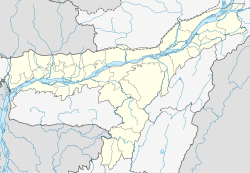Digboi
| Digboi | |
|---|---|
| town | |
| Nickname(s): The Oil Town | |
| Location in Assam, India | |
| Coordinates: 27°23′N 95°38′E / 27.38°N 95.63°ECoordinates: 27°23′N 95°38′E / 27.38°N 95.63°E | |
| Country |
|
| State | Assam |
| District | Tinsukia |
| Government | |
| • Body | Digboi Municipality |
| Elevation | 165 m (541 ft) |
| Population (2001) | |
| • Total | 20,405 |
| Languages | |
| • Official | Assamese |
| Time zone | IST (UTC+5:30) |
| PIN | 786171 |
| ISO 3166 code | IN-AS |
| Vehicle registration | AS |
Digboi (IPA: ˈdɪgˌbɔɪ) (Assamese: ডিগবৈ) is a town and a town area committee in Tinsukia district in the north-eastern part of the state of Assam, India
Crude oil was discovered here in late 19th century. Digboi is known as the Oil City of Assam where the first oil well in Asia was drilled. The first refinery was started here as early as 1901. Digboi has the oldest oil well in operation. With a significant number of British professionals working for Assam Oil Company until the decade following independence of India, Digboi had a well-developed infrastructure and a number of bungalows unique to the town. It has eighteen holes golf course as part of the Digboi Club. It has guest houses and tourist residential apartments laid on Italian architectural plan to promote tourism in upper Assam.
" Barely seven years after Edwin L. Drake drilled the world's first oil well in 1859 at Titusville, Pennsylvania, USA, history registered another exploration of the black liquid gold, in the largest continent. More than a century ago, history was made in a remote corner of Assam in the midst of the dense and malaria infested jungles, by a band of intrepid pioneers searching for black gold. In 1867 Italian Engineers, commissioned by the Assam Railways and Trading Company, to build a railway line from Dibrugarh to Margherita (Headquarters of Assam Railways and Trading Company) accidentally discovered oil at Digboi around 10 miles from Margherita. ‘Dig boy, dig’, shouted the English engineer, Mr W L Lake, at his men as they watched elephants emerging out of the dense forest with oil stains on their feet". This is possibly the most distilled – though fanciful – version of the legend explaining the siting and naming of Digboi. Two events separated by seven years have become fused, but although neither is likely to be provable, such evidence that does exist appears sufficiently detailed to be credible.
Various web sites offer variations on the elephant’s foot story, a consensus of which would be that engineers extending the Dibru-Sadiya railway line to Ledo for the Assam Railways and Trading Company (AR&TC) in 1882 were using elephants for haulage and noticed that the mud on one pachyderm’s feet smelled of oil. Retracing the trail of footprints, they found oil seeping to the surface. One of the engineers, the Englishman Willie Leova Lake, was an ‘oil enthusiast’ and persuaded the company to drill a well.
Oil India Ltd makes no reference to elephants’ feet in its company history, although on its previous web site the company noted that Lake had noticed "the oil seepages around Borbhil". Once the project had been approved, Lake assembled equipment, boilers, and local labour, and engaged elephants to haul the machinery to the site. The first well was started in September 1889, but an encouraging first strike at 178 feet (54 m) turned out to be a small pocket, and drilling recommenced. This continued until November 1890 when the well was completed at a total depth of 662 feet (202 m), and it was during this extended period of drilling that Oil India's old web site placed the legend of Lake exhorting one or more of his labourers to "Dig, boy!"
...
Wikipedia


